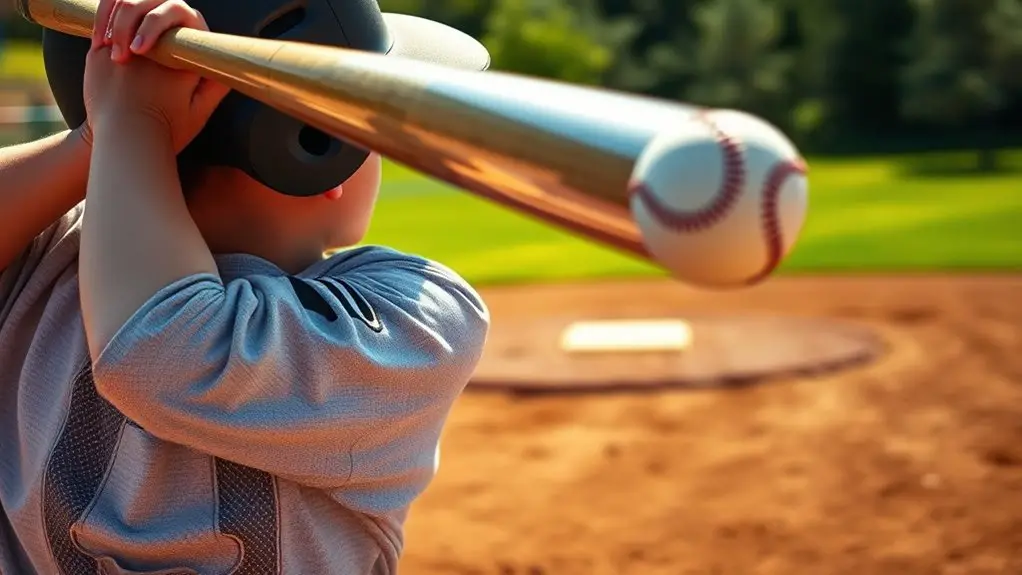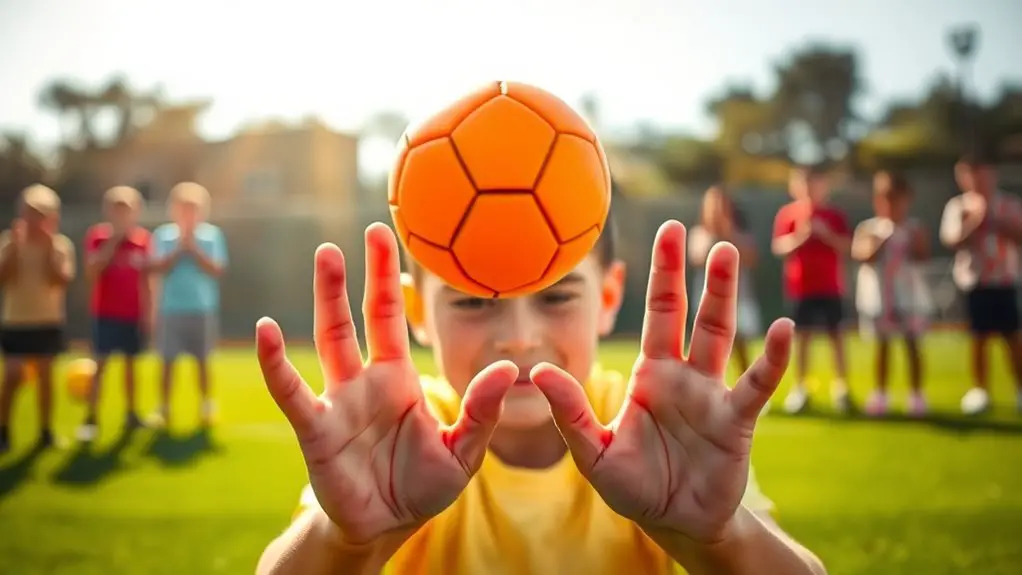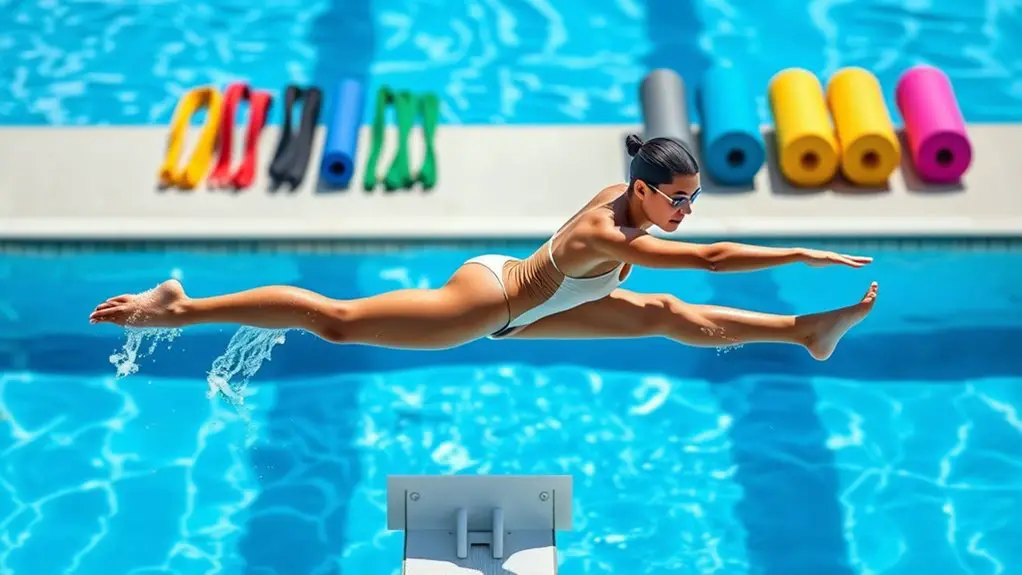To improve your batting reaction time, focus on enhancing your hand-eye coordination through specific drills and practice. Use quick pitch drills, reaction ball exercises, and batting cage practices to sharpen your skills. Incorporating technology like video analysis can help track your progress and reveal areas for improvement. Don't forget to develop mental strategies for quick decision-making, and maintain good physical conditioning to boost your reflexes. There's much more to explore in refining your game.
Understanding Batting Reaction Time
Batting reaction time is essential for any player looking to excel at the plate. It's not just about swinging the bat; it's about mastering the batting fundamentals that allow you to respond swiftly to pitches. Your cognitive processing plays a critical role here. When you're at the plate, your mind needs to analyze the pitch's speed and trajectory almost instantly.
To improve your reaction time, focus on drills that sharpen your reflexes and decision-making skills. These exercises can boost your awareness and help you anticipate the pitch, giving you that split-second advantage. Remember, it's all about freedom—freedom to react without hesitation, to trust your instincts, and to let your training take over in the heat of the moment. Furthermore, investing in reaction time refinement is essential for serious players looking to enhance their performance. Embrace the process, and you'll find yourself becoming a more formidable player, ready to seize every opportunity that comes your way.
Importance of Hand-Eye Coordination
Mastering hand-eye coordination is crucial for any player aiming to enhance their batting skills. This coordination allows you to connect your visual tracking with your physical movements, ensuring you can respond quickly to pitches. When you see the ball coming, your brain's cognitive processing kicks in, helping you judge speed, angle, and distance.
The better your hand-eye coordination, the more accurately you can time your swing and make contact with the ball. It's the difference between a solid hit and a swing and a miss. Practicing this skill can be liberating, allowing you to express your unique batting style while improving performance.
As you develop your hand-eye coordination, you'll find that your confidence grows, making it easier to focus on the game instead of worrying about timing. So, embrace the journey and enjoy the freedom that comes with mastering this crucial skill!
Drills to Enhance Reaction Time
To boost your batting reaction time, you can incorporate specific drills into your practice. Quick pitch drills, reaction ball exercises, and batting cage practices are all effective ways to sharpen your skills. Let's explore how each of these drills can make a difference in your performance.
Quick Pitch Drills
While it may seem challenging to improve your reaction time at the plate, quick pitch drills can make a significant difference. These exercises focus on enhancing your pitch recognition and timing adjustments, allowing you to better anticipate pitches. Here are some effective quick pitch drills to try:
- Partner Toss: Have a partner throw pitches at a quick pace.
- Machine Work: Use a pitching machine set to varying speeds.
- Countdown Drill: Have a coach call out numbers before pitch delivery.
- Visual Cues: Focus on recognizing different pitch types before they're thrown.
- Shadow Swings: Practice your swing rhythm without a ball, maintaining quickness.
Incorporating these drills into your practice will boost your ability to react swiftly during games.
Reaction Ball Exercises
One effective way to enhance your batting reaction time is through reaction ball exercises. These drills can greatly improve your hand-eye coordination and overall agility, making you more responsive at the plate. To get started, use a reaction ball, which bounces unpredictably. As you throw it against a wall, focus on catching it as it rebounds. This not only sharpens your reflexes but also helps you anticipate movement better. Incorporating varied reaction ball techniques, like catching with one hand or from different angles, can further boost the reaction ball benefits. By consistently practicing these exercises, you'll feel more in control and ready when it's your turn to bat, ultimately elevating your game.
Batting Cage Practices
Batting cage practices offer an excellent opportunity to sharpen your reaction time in a controlled environment. By focusing on specific batting cage techniques, you can maximize your potential. Make sure you've got the right equipment selection for an ideal experience. Here are some drills to examine:
- Fast Pitch Drills: Increase pitch speed to challenge your reflexes.
- Short Toss: Work on timing by hitting from close range.
- Reaction Ball Drills: Use a reaction ball to improve hand-eye coordination.
- Pitch Recognition Drills: Identify pitch types quickly to enhance decision-making.
- Target Practice: Aim for specific zones to develop precision and control.
Embrace these practices, and you'll see significant improvements in your reaction time at the plate!
Utilizing Technology for Improvement
In today's game, technology can greatly boost your batting reaction time. By leveraging video analysis tools, virtual reality training, and mobile apps, you can gain insights and practice more effectively. Let's explore how these innovations can enhance your skills on the field.
Video Analysis Tools
Harnessing the power of video analysis tools can greatly enhance your batting reaction time. By utilizing video feedback, you can pinpoint areas that need improvement and track your progress through performance analysis. Embrace technology to reveal your true potential and enjoy the freedom that comes with mastering your skills.
- Capture your swings from different angles.
- Analyze your stance and swing mechanics.
- Review your timing against various pitch speeds.
- Identify patterns in your hitting approach.
- Set specific goals based on your analysis.
With these insights, you'll be better equipped to make adjustments, refine your technique, and ultimately elevate your game. Embrace the journey of improvement and let video analysis be your ally in achieving batting excellence.
Virtual Reality Training
While traditional training methods have their merits, virtual reality (VR) training takes your practice to a whole new level by immersing you in realistic game scenarios. With VR, you can step into virtual simulations that replicate the fast-paced action of the diamond, allowing you to sharpen your batting reaction time like never before. These immersive experiences help you develop quick decision-making skills and improve hand-eye coordination without the pressures of a live game. You can practice at your own pace, facing different pitchers and situations that challenge your abilities. This freedom to explore various scenarios not only keeps training exciting but also enhances your overall performance. Embrace VR training and watch your batting skills soar to new heights!
Mobile Apps Integration
As you look to enhance your batting reaction time, integrating mobile apps into your training routine can be a game-changer. These apps offer tailored exercises, track your progress, and provide instant feedback. Here are some app recommendations to take into account based on user reviews:
- Batting Trainer: Focuses on hand-eye coordination.
- Quick Reflex: Improves reaction speed with fun drills.
- Pitch Tracker: Analyzes pitch types and speeds.
- Baseball IQ: Enhances your understanding of game situations.
- Skill Builder: Offers customizable workouts for specific skills.
Using these tools, you can develop a flexible training schedule that fits your lifestyle. Embrace the freedom to train anywhere and let technology elevate your game!
Mental Strategies for Quick Decision-Making
To enhance your batting performance, developing mental strategies for quick decision-making is essential. Start by using mental imagery; visualize yourself in a game, facing different pitches. Picture the ball coming towards you, and imagine your perfect swing connecting. This mental rehearsal can sharpen your instincts, helping you react faster when it counts.
Incorporate focused breathing into your routine. When you feel pressure, take a moment to breathe deeply, calming your mind and body. This technique not only reduces anxiety but also sharpens your focus, allowing for clearer decision-making. Practicing mindfulness techniques can also help ground you in the present moment, further enhancing your ability to respond quickly.
Practice these strategies regularly, and soon you'll find that your mind can keep pace with your body. By combining mental imagery with focused breathing, you'll create a powerful toolkit for faster reactions and smarter choices at the plate. Embrace these techniques, and enjoy the freedom they bring to your game!
Physical Conditioning for Better Reflexes
Enhancing your physical conditioning is essential for developing better reflexes at the plate. By focusing on specific types of training, you can boost your overall performance and reaction time. Here are key areas to concentrate on:
- Strength training: Build muscle power for quicker swings.
- Agility drills: Improve your footwork and speed in reacting.
- Plyometric workouts: Increase explosive movements for faster responses.
- Core stability: Strengthen your core for better control and balance.
- Endurance conditioning: Maintain your energy levels throughout the game.
Including flexibility exercises and balance training will further enhance your coordination. Don't forget to incorporate sport-specific workouts and neuromuscular training to sharpen your reflexes. By engaging in these practices, you'll not only feel more liberated on the field but also become a more dynamic and responsive player. Embrace the freedom of movement, and watch your batting improve! Additionally, integrating agility training techniques can significantly enhance your ability to respond quickly to pitches.
Practicing With Live Pitching
Building on your improved physical conditioning, practicing with live pitching is an essential way to sharpen your batting reaction time. There's nothing quite like facing a real pitcher to help you develop your instincts and decision-making skills. Start by integrating live pitch simulations into your training routine. This gives you the chance to react to different pitch speeds and styles, honing your ability to adapt on the fly.
Incorporate game scenario practices into your sessions, where you can replicate the pressure and excitement of an actual game. This not only enhances your timing but also builds your confidence to handle high-stakes situations. Don't shy away from challenging pitches; embracing these moments will empower you to respond quicker and more effectively. Additionally, incorporating agility ladder drills into your training can further enhance your foot speed and coordination, contributing to quicker reactions. By consistently practicing with live pitching, you're paving the way for improved reaction times and overall performance at the plate.
Tracking Progress and Setting Goals
How can you effectively track your progress and set achievable goals for improving your batting reaction time? Start by keeping a record of your performance. This isn't just about stats; it's about understanding your growth. With solid progress tracking and goal setting, you'll find yourself motivated and focused.
- Log the drills and techniques you practice.
- Use a timer to measure your reaction times consistently.
- Set specific, measurable, attainable, relevant, and time-bound (SMART) goals.
- Reflect on your progress weekly to tweak your approach.
- Celebrate small victories to keep your spirits high.
Additionally, remember that intrinsic motivation fosters long-term commitment, helping you stay engaged and passionate about your improvement. This freedom in your training guarantees you're not just grinding but genuinely evolving. You'll see how each session contributes to your overall improvement, giving you the confidence to tackle challenges head-on. So, embrace the journey—your batting skills will flourish!
Frequently Asked Questions
What Age Is Ideal for Starting Reaction Time Training?
When it comes to youth training, starting reaction time exercises around ages 10 to 12 can be ideal. At this age, kids are developing coordination and can benefit from activities that enhance their reflexes. Early training helps set a strong foundation for future skills. By engaging in fun drills, you'll not only improve their response times but also foster a love for the game, giving them the freedom to explore their athletic potential.
Can Diet Affect Batting Reaction Time?
Imagine your body as a finely-tuned machine, where every part relies on the others for peak performance. Can diet affect your batting reaction time? Absolutely! Nutrient timing plays a vital role in fueling your energy, while proper hydration strategies keep you focused and agile. By optimizing your diet, you're not just feeding your body; you're enhancing your reflexes and giving yourself the freedom to react swiftly and confidently on the field.
How Do Sleep Patterns Influence Reaction Time?
Sleep patterns play an essential role in your reaction time. When you're sleep deprived, your brain struggles to process information quickly, affecting your performance. Getting quality sleep helps you complete REM cycles, which are important for cognitive functions. If you want to feel free and agile, prioritize your rest. Embrace a sleep routine that allows your mind and body to recharge, so you can react faster and enjoy the game more.
Are There Specific Sports That Enhance Batting Reaction Time?
Ever wondered which sports could sharpen your reaction time? You might be surprised to learn that baseball drills and tennis practice are top contenders. Both sports require quick decision-making and rapid responses, pushing you to enhance your reflexes. While swinging a bat or returning a serve, you'll find yourself honing those skills. So, if you're craving that freedom to react faster, diving into these sports could be your perfect escape.
Can Injuries Impact Batting Reaction Time Recovery?
Injuries can definitely impact your batting reaction time recovery. If you're sidelined, it's essential to focus on rehabilitation techniques that not only help heal but also maintain your skills. Incorporating injury prevention strategies into your routine can keep you in the game longer. Remember, taking care of your body is key to staying free and agile, allowing you to bounce back stronger and quicker when you return to the plate.




